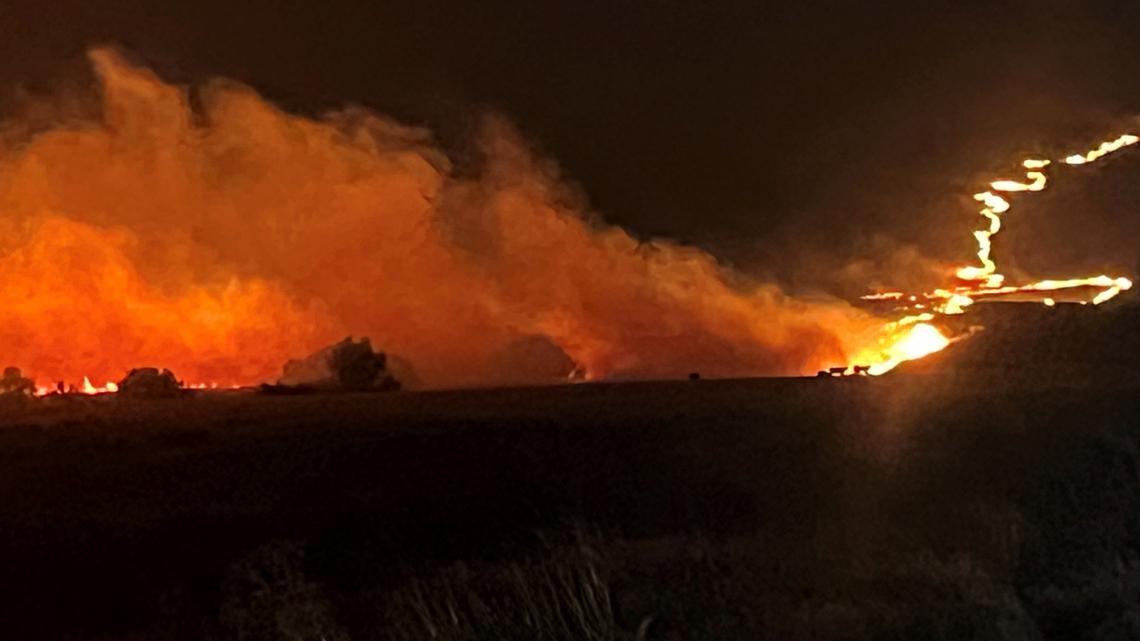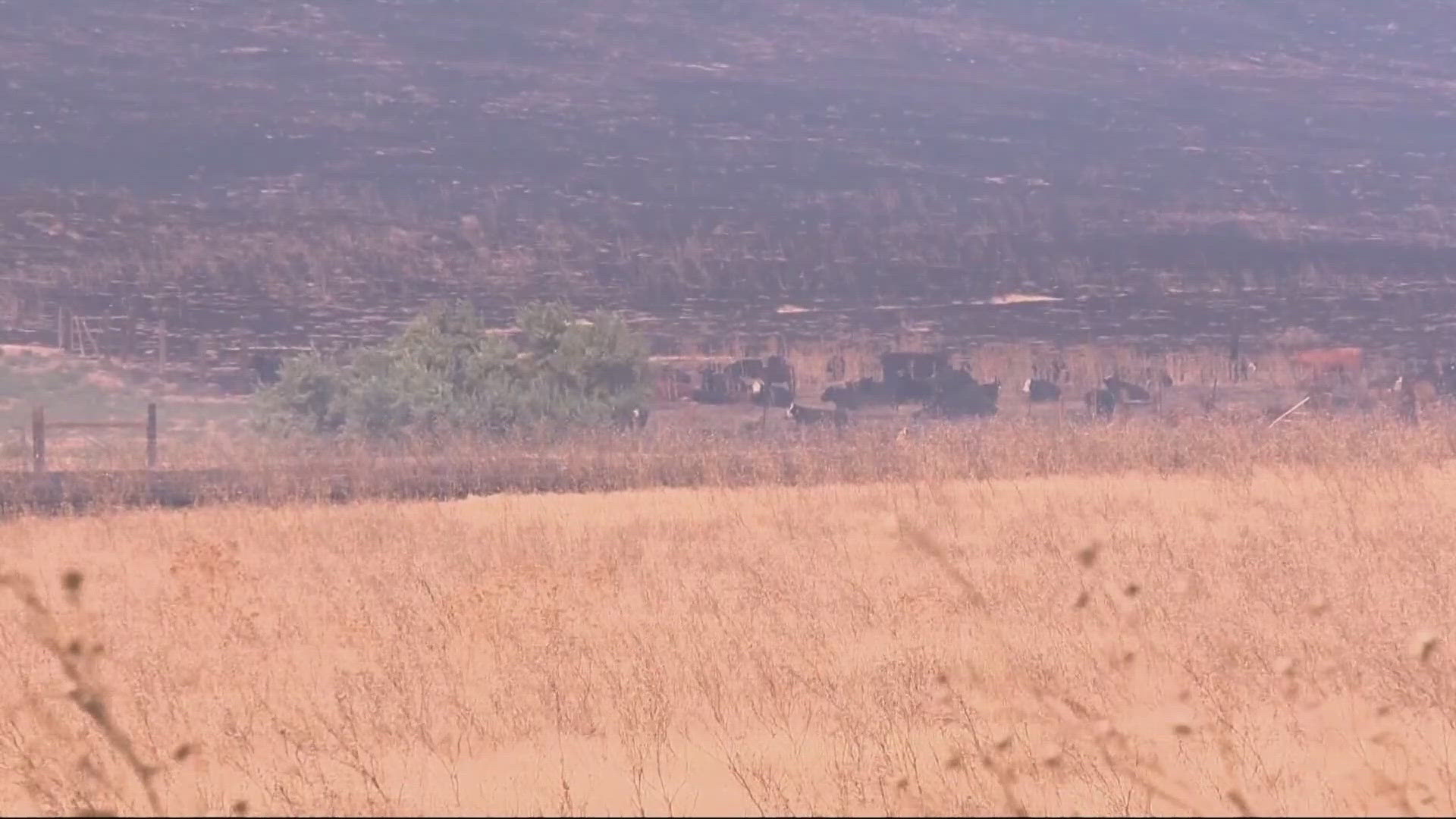PORTLAND, Ore. — The Durkee Fire in eastern Oregon has become the largest wildfire currently burning in the country and is now the No. 1 priority nationally, according to the Northwest Interagency Coordination Center, but some rainfall might be aiding the fight.
The fire, burning near the Oregon-Idaho border, has grown to nearly 270,000 acres as of Wednesday evening and remains 0% contained. It has destroyed two homes and 12 other structures as of Wednesday evening.
Baker County Sheriff Travis Ash said the Wednesday night rainfall on the Durkee Fire was a "godsend." With it, the Baker County Sheriff's Office anticipates there will be a reduction in evacuation levels on Thursday; the city of Huntington was reduced from a Level 3 evacuation level (Go Now) to a Level 1 (Be Ready).
However, Durkee Fire has prompted on-and-off again closures of a stretch of Interstate 84 for days. On Wednesday afternoon, the fire crossed the interstate near the town of Huntington, home to about 500 people. It also merged with the Cow Valley Fire burning in nearby Malheur County, Gov. Tina Kotek said.
“The wildfires in eastern Oregon have scaled up quickly,” Kotek said in a statement Wednesday afternoon. “We are facing strong erratic winds over the region that could impact all fires. Rain is not getting through. Some communities do not have power. The situation is dynamic, and the teams on the ground are taking it day by day."
The governor said she's deployed the National Guard to the region.
The Durkee Fire is one of dozens of wildfires burning throughout the state. Oregon was hit by a series of thunderstorms last week that triggered an estimated 2,000 lightning strikes statewide, according to the Oregon Department of Forestry, sparking a massive wave of new wildfires that together put Oregon in a worse position than any other state both in terms of the number of major active fires and number of acres burned.
"Right now, we have 22,000 firefighters deployed across the nation. The northwest has almost half of those, right here in Oregon and Washington," said Carol Connolly with the Northwest Interagency Coordination Center.
Of the 44 major wildfires burning in the two states, 34 are in Oregon, she added.
Lightning strikes sparked the Durkee Fire on July 17, not far from the Cow Valley Fire, which at the time was one of the largest wildfires in the state. Crews were able to bring the Cow Valley Fire largely under control over the following days — it's 91% contained as of Wednesday morning — but the Durkee Fire spread rapidly at the same time.


Wednesday's weather was expected to lead to "extreme fire behavior and growth," fire officials warned, with a Red Flag Warning issued for more thunderstorms on the way, potentially bringing wind gusts of up to 75 mph.
High winds and poor visibility will likely force aerial firefighting resources to stay grounded or limit their operations. Any amount of rainfall from the storms could also set off landslides or flash floods in the burned-out areas.
"There's a lot of hard work being put in day and night," said Sarah Sherman, an agency administrator for the Bureau of Land Management, during a virtual community meeting Wednesday night. "This fire isn't cooperating by any means, usually we can create a lot of headway and progress at night but that seems to be when the winds are picking up for us."
For days, the Durkee Fire has sparked off-and-on closures of a wide stretch of Interstate 84. Crews initially announced Monday that the freeway would close overnight between Baker City and Ontario for the next several nights to create more space for the wildfire response. On Tuesday, they were forced to shut the same stretch of freeway down during the day, as the fire got too close to the road.
The freeway reopened Tuesday evening but then closed again for the scheduled overnight shutdown. It reopened Wednesday morning, but the closure was again put back in place later in the morning and extended north to Pendleton. The Oregon Department of Transportation said travelers should prepare for additional closures and should not rely on the I-84 route due to unpredictable fire behavior.
"We're encouraging people, if they must travel east-west through Oregon, that they consider it might be a little out of the way, but to consider to travel on U.S. 20," said Vicki Moles with ODOT.
She also urged drivers to use ODOT's TripCheck map to look for closures and plan their route, rather than relying on GPS guidance, which may not be updated with the latest closures or conditions on the ground.
The Durkee Fire is burning to the west of I-84, but a separate smaller fire, called the Thompson Fire, is also burning to the east. That fire is a convergence of multiple small fires sparked by lightning on Monday, officials said. High temperatures, strong winds and dry fuels have combined to make both fires keep growing rapidly.
Multiple areas in both Malheur County and Baker County are under Level 3 "Go Now" evacuation orders, meaning residents should leave immediately and not return to their property until the evacuations are lifted. The American Red Cross has set up a shelter at the Malheur County Fairgrounds at 795 NW 9th Street in Ontario.
A statewide evacuation map is available online, and more specific instructions are available on the Facebook pages for the Malheur County Sheriff's Office and Baker County Sheriff's Office.
Idaho Power's service area extends into Oregon and includes Ontario and much of the area around the Durkee Fire. The utility issued a warning Wednesday morning that extreme weather conditions in eastern Oregon and western Idaho could require emergency safety power shutoffs to decrease the risk of sparking further wildfires. Outages will likely start between 5 p.m. and 10 p.m. Wednesday if they become necessary.

